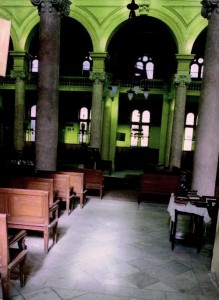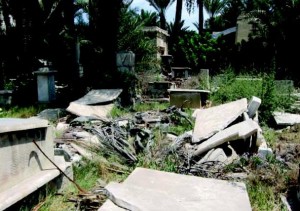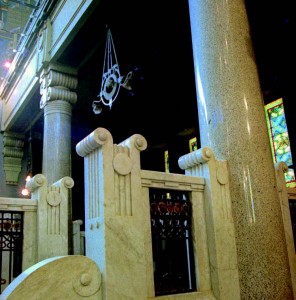Once proud and flourishing, the Jewish communities of Egypt are today on the verge of extinction. With a generous research grant from the Orthodox Union, Dr. Ari Greenspan and Rabbi Dr Ari Z. Zivotofsky recently visited the dwindling Egyptian Jewish communities of Alexandria and Cairo to offer hope and encouragement to the few remaining Jews and to learn more about the rich Jewish life that once was.
ALEXANDRIA, EGYPT
Jews have lived in Alexandria since 332 BCE, shortly after the city was first founded. Alexander the Great encouraged Jews to move there, and they did in great numbers. Indeed, the Talmud discusses the massive synagogue of Alexandria in which those sitting in the back could not hear the cantor, so large was the synagogue. Centuries later, in Maimonides’ day, Cairo’s Jewish community was a center of Jewish commerce and scholarship.
Even in modern times, Jewish life flourished in Alexandria. Up until the 1940s, as many as 80,000 Jews lived in Egypt, significantly contributing to the country culturally and economically. But after the birth of Israel in 1948, and in the aftermath of the Arab-Israeli wars, thousands of Jews fled Egypt. The shuls were sold, torn down and built over or locked up. Today, there are fewer than fifty Jews—most of whom are intermarried, elderly and poor—left in all of Egypt. Insecure and afraid, the few Jews left are careful not to draw attention to themselves.
The Eliyahu Hanavi Synagogue, Alexandria, Egypt, 1994. The synagogue on Nabi Daniel Street once served as the central synagogue of Alexandria.
While making travel arrangements we discovered that Israel does not exist on the Egyptian airline web site. Despite Egypt’s peace treaty with the Jewish State, relations between the two countries remain tense. The demonizing of Israel and of Jews is common in the Egyptian press.
A policeman approached us when we arrived at the Alexandria airport, and we soon realized that a police escort had been arranged for us for the duration of our stay. With the rise of Islamic fundamentalism in the country, we were not ungrateful for the protection. (In fact, the security situation in Egypt is such that all shuls are heavily guarded at all times.) Interestingly, the locals we met were consistently friendly and gracious. Throughout our day-and-a-half stay in Alexandria, four policemen did not leave our side, not even at 2:00 AM when we went for a stroll in the still-bustling souk (market).
Yosef Gaon, the head of the tiny Jewish community in Alexandria, gave us a fascinating tour of what Jewish Alexandria was like decades ago.
Today, the sole intact shul in Alexandria is the 150-year-old Eliyahu Hanavi Sephardic synagogue. One of the largest synagogues in the Middle East, the magnificent building sits within a courtyard that once contained the Jewish school, the mikvah and the various communal offices.
 Dr. Greenspan (right) and Rabbi Dr. Zivotofsky with two of the four Egyptian policemen who accompanied them during their visit to Alexandria. Courtesy of Ari Z. Zivotofsky.
Dr. Greenspan (right) and Rabbi Dr. Zivotofsky with two of the four Egyptian policemen who accompanied them during their visit to Alexandria. Courtesy of Ari Z. Zivotofsky.
A viable Jewish community needs a variety of institutions, and Alexandria has at least one very useful one: a well stocked and organized Jewish library. It is unfortunately not used much (although we greatly enjoyed leafing through the tomes), and the Egyptian government prefers that it remain locked. But there are over a dozen bookcases full of Jewish books including Gemarot, the Shulchan Aruch and hundreds of books of responsa. However, you will not find books published within the past fifty years. Everything in the library is older than that; many are 150 years old and older. The existence of such an impressive library indicates that the kehillah in Alexandria was once vibrant and learned.
We noticed roll-on stampers used to designate kosher meat among the artifacts our guide showed us. Not too long ago, Alexandria had its own kosher slaughtering house under local rabbinic supervision, but sadly, today, there is no one left in Alexandria to support such an enterprise.
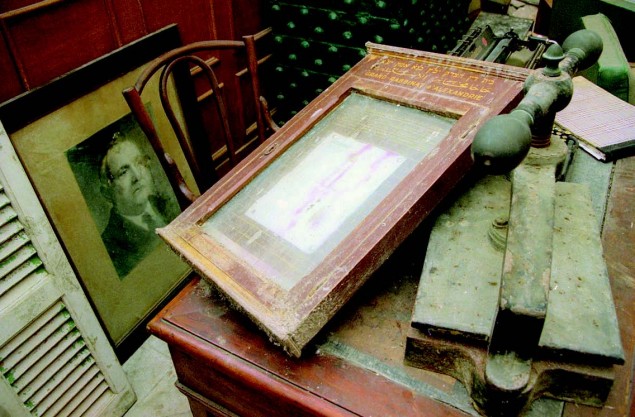 The former Beit Din of the Jewish community in Alexandria. Photos, except where noted otherwise, were taken by Shlomo Taitz, Israel (Beit Hatfutsot Photo Archive).
The former Beit Din of the Jewish community in Alexandria. Photos, except where noted otherwise, were taken by Shlomo Taitz, Israel (Beit Hatfutsot Photo Archive).
We had another capable, if unusual, guide, in addition to Gaon: Abed Al Nabi, a Muslim from southern Egypt, who has worked for the Jewish community for decades and speaks fluent Hebrew. Nabi took us to see the mikvah in the community compound, which still exists but is no longer in use. He also showed us the matzah making machinery, which is rusty and old, but still in the community’s possession. The communal offices include a “court room” where the beit din used to convene and a large communal school building, which is today used as a Muslim school. The guided tour through the once Jewish buildings led by a Hebrew-speaking Egyptian was somewhat surreal.
Sixty sifrei Torah from all the shuls in Alexandria have been collected by the government and are now housed in the Eliyahu Hanavi Sephardic synagogue. The only other remaining shul in town is run down and, although still guarded by police, appears slated for destruction. The city has three Jewish cemeteries in various states of disrepair. Many tombstones are cracked, but the cemeteries are not entirely neglected. Non-Jewish caretakers tend to the cemeteries and live on the cemetery grounds. The vastness of the cemeteries and the magnificence of many of the tombstones attest to the impressive size and affluence of the community that once existed.
During our visit, we heard a fascinating story about a Jewish Anussah, or Marrano, who was taken by a Muslim man as a young girl and wed to him against her will. Although she had to convert to Islam, she stubbornly kept her Jewish soul alive for all sixty years of her married life. During that time, she could not live a Jewish life and even her three daughters do not know that they are Jewish. However, ever since her husband died, she began attending shul. Unfortunately, as she lives among Muslims, she was too afraid to meet with us.
Alexandria’s Jewish cemeteries are in various states of disrepair. Courtesy of Ari Z. Zivotofsky.
CAIRO
We left Alexandria via train and headed to Cairo, a filthy, noisy metropolis of close to seven million people. Cairo is home to one of the world’s oldest Jewish communities. It is not known exactly when the Jewish community of Cairo was first established, but it was certainly many centuries ago. Currently, no more than a score of elderly women comprise the Cairo Jewish community. The majority of the city’s Jews were driven out decades ago by mob violence and state-sponsored persecution related to the Israeli-Arab conflict. Many Jews were evicted or arrested; their bank accounts were frozen and properties were seized. Reverberations from some of these seizures are still being felt. (An example is the ongoing litigation being handled by Nathan Lewin on behalf of Refael Bigio, an Egyptian Jew who is accusing Coca-Cola of illegally benefiting from his factory that was nationalized in 1962 by Nasser’s regime.) Many other Egyptian Jews left of their own accord, hoping for a brighter future elsewhere.
 Entrance to Sha’ar Hashamayim Synagogue, Cairo.The site is protected by Egyptian security guards.
Entrance to Sha’ar Hashamayim Synagogue, Cairo.The site is protected by Egyptian security guards.
Within this crowded city, one can still find a number of synagogues. We visited the oldest and most famous synagogue in Cairo: the Ben Ezra Synagogue, thought to date back to 882, located in the Fustat area of Coptic Cairo, the old Jewish neighborhood. Today no services are held there. The Rambam used to pray and hold court in this shul, and in 1896 the famous “Cairo Genizah,” one of the most valuable troves of historical documents ever discovered, was found in its women’s gallery.
The Teva (detail), Sha’ar Hashamayim Synagagoue, Cairo.
For the better part of the twentieth century, the building was left to deteriorate. However, in 1983, following the Camp David Accords, the Egyptian government realized the historical value of the shul and began to restore it, down to its marble pillars and ceiling painted in muted greens and reds—a project that took more than ten years to complete. The mikvah in the basement is still in a terrible state of disrepair. The restoration of the women’s gallery is in progress, and visitors are not allowed in. However, the president of the Cairo Jewish community, Carmen Weinstein, graciously arranged for us to visit the women’s gallery and see the entrance to the “attic” where the genizah was found.
While we were there, many groups of tourists—mostly Asian and European— flowed in and out. Interestingly, we did not see any Jewish, American or Israeli tourist groups.
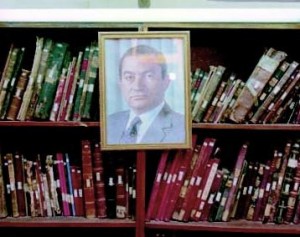 The Egyptian Jewish Heritage Library, Cairo. The portrait of President Hosni Mubarak is displayed in the library, which is located in the Sha’ar Hashamayim Synagogue.
The Egyptian Jewish Heritage Library, Cairo. The portrait of President Hosni Mubarak is displayed in the library, which is located in the Sha’ar Hashamayim Synagogue.
In recent years, the Egyptian government has come to accept that preserving the country’s rich Jewish heritage and religious sites is its responsibility since the tiny Jewish community there lacks the funds to do so. A yeshivah and shul known as “Rav Moshe,” one of Cairo’s most historic synagogues, and the grand-looking Karaite synagogue of Cairo were recently restored by the Egyptian government and rededicated. The government pledged to restore six more synagogues in the next two years. There are several other shuls in Cairo, but most are dilapidated and closed to the public. The one exception is the Sha’ar Hashamayim synagogue, also known as the Adli Street Synagogue, founded more than one hundred years ago. A structure of gray stone, the synagogue has carpeted floors and gold-painted walls. In the 1940s, upper-class Jews would fill its pews on Shabbat. On a recent Shabbat, it was empty. On rare occasions, such as when the Israeli embassy makes a request, minyanim are held there. The government uses it for all Jewish “functions” and thus it was there that Israeli POWs were paraded in the aftermath of the Yom Kippur War. This past February, a makeshift bomb was thrown at the historic shul, but fortunately it failed to detonate.
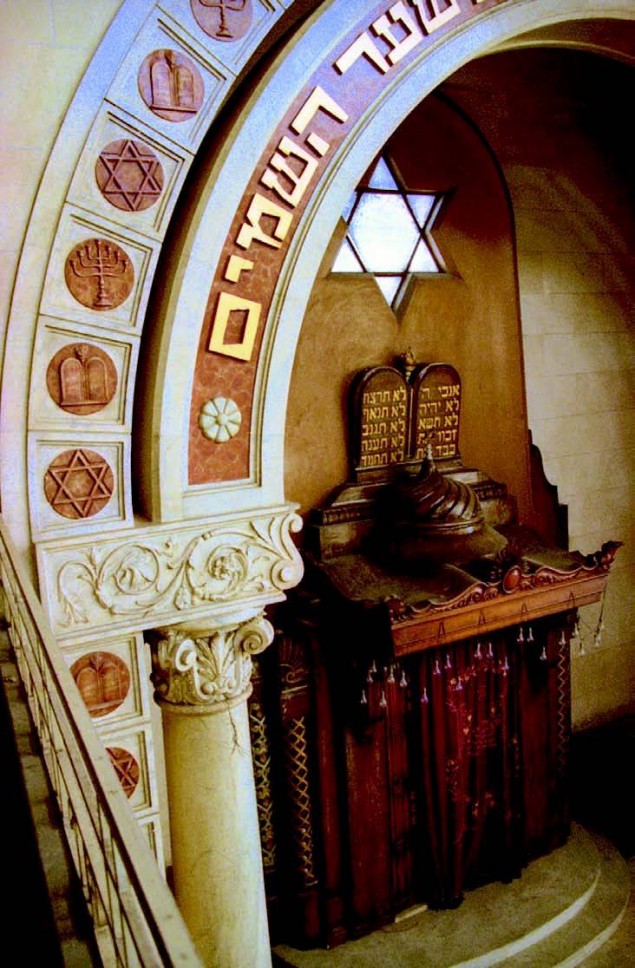 The Ashkenazi Synagogue, Cairo.
The Ashkenazi Synagogue, Cairo.
Kosher food is not available in Cairo. The Jewish school ceased functioning over fifty years ago, and we were told that it is dangerous to visit the Jewish cemetery—not a promising future for a Jewish community. What is left of this once-grand Jewish community? Books. There are three significant Jewish libraries in Cairo. Books from many of the now-destroyed shuls were collected and in 1989, a 7,000-book library was established. In 1997, a 3,000-volume library was inaugurated next to the Ben Ezra Synagogue, and a smaller library exists next to the large Karaite synagogue.
Dr. Ari Greenspan, a US-trained dentist with a practice in Jerusalem, is a co-founder of the Ptil Tekhelet Association. He is also a mohel, shochet and sofer, and has spent more than twenty years collecting Jewish traditions from far-flung Jewish communities.
Rabbi Dr. Ari Z. Zivotofsky, a Jewish Action columnist, is on the faculty at Bar-Ilan University. He is also a shochet, has a master’s in Jewish history, and writes widely on topics of Jewish interest.
